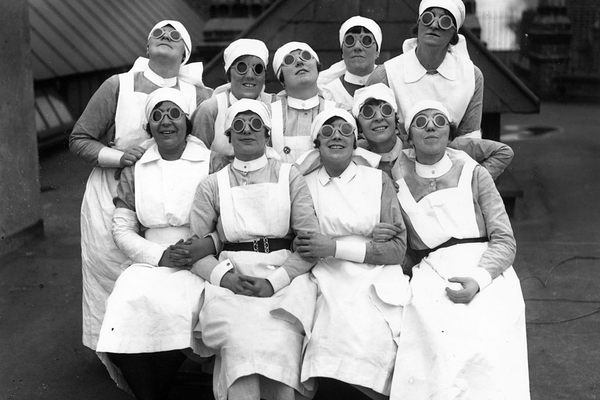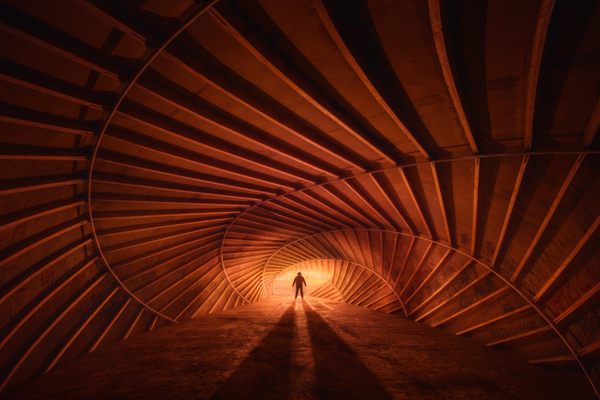Shanghai’s Daring ‘Rooftoppers’ Are Taking Urban Exploration to New Heights
But a local crackdown on building access is making expeditions more difficult.
“Do you know how many lightning rods you can climb in Shanghai? The answer is 23. Of course, there are many more for us yet to discover.”
That text accompanies the above Instagram post from user cocoanext—one of a ballsy group of Shanghai-based “rooftopper” photographers. His images often show a smog-masked figure, sometimes with a selfie stick in hand, on top of a spire less than a foot wide or similarly seemingly impossible location. The backdrops feature vast panoramas of high-rise buildings, the wide angle splaying their roof tops like grass stalks bending in the wind.
The term “roof topping”—coined in the 2005 urban exploration manual Access All Areas—involves accessing rooftops and other high vantage points of metropolises around the world. Its popularity began soaring around 2011 with the ascent of social media platforms, particularly Instagram. In China the roofer community is relatively small compared to Western cities, with only about 30-40 people. But in a country sprouting new crops of tall buildings every year, the art has reached new heights. Shanghai is an obvious mecca, with a building program so massive that the city is sinking at around two centimeters—over three-fourths of an inch—per year due to the weight of all the new glass, steel and concrete goliaths. And it’s produced a whole new terra incognita of rooftops to explore, otherwise known only to the construction workers who built them.
In contrast to urban aerial images captured using drones, roof-topper photography exudes a sense of sheer elation at being there. Images often feature a lone figure on a spire, crane boom or precipitous ledge peering into the urban abyss. A tiny human exclamation point in response to the sheer immensity of the vista.
In one night shot a cyber punky figure climbs a narrow spire above an urban canyon backlit by the street level glow. It’s like an illustrated cover for an Isaac Asimov novel—except that it’s breathtakingly real.
Foregrounds may feature a pair of trouser legs and sneakers hanging nonchalantly over a dizzying drop, reminding you that someone actually managed to climb up there and hold the camera steady—as well as revealing the photographer’s taste in footwear. Sometimes the climbing feats captured are even scarier—like cocoanext’s photo of a mirror-shaded climber clinging one-handed to a thick metal cable on the roof. The images are rich fodder for hungry social media platforms and every week, tens of thousands of followers vicariously enjoy these vertiginous visions on their smartphones.

The core of Shanghai’s roofer community is made up of small, close-knit groups of two to three people, often posting on social media platforms via pseudonyms. Like several of them, cocoanext came to roof topping from the visual arts. “I was a photographer before I started urban exploring, but I was only doing portraits,” he says. “Then two years ago I came across some photos by blackstationwang, a local Shanghainese architecture photographer.”
Since then cocoanext says he’s been inspired to explore the city from a whole new perspective with his team mate roofercyril. On occasion he shoots with a couple of other prominent Shanghai rooftop photographers, panvelvet and jenniferbin. “We don’t have an organization or anything like that, but we have our own social circle.”

Toronto-born Bin works in Shanghai as a UI/UE designer. Reputedly one of the most followed Instagrammers in China, she’s renowned for her bright pink hair and dazzling, sci-fi fandom-infused futuristic posts. This past winter Bin spent over 10 cold overnight hours on a rooftop expedition near the Bund—Shanghai’s waterfront area—with two teammates, waiting for the sun to rise. “As the sky became brighter, we were rewarded with low fog following along the river and the sun inching up in the sky.”
With such premium views usually only accessible to an ultra-wealthy penthouse elite, roofers like Bin feel that they’re liberating these views for wider enjoyment. That takes nerves of steel. Reporting for That’s Shanghai, journalist Dominic Ngai tagged along on one of their excursions only to find his legs shaking uncontrollably. The height didn’t seem to bother the experienced photographers he was with—“it’s become part of their lives,” he wrote.

Extreme tenacity is another roofer prerequisite. It took cocoanext 13 attempts to make it onto his current favorite Shanghai rooftop, the Royal Meridien Hotel. Why go to all that trouble? “The coolest thing about it are its two spires which are the tallest in Shanghai,” he says. “To accomplish something like this is thrilling and full of surprises as well as danger.”
The GoPro selfie he took on the Royal Meridien’s lightning rod is his most prized shot so far. ”I waited for a whole year for the opportunity to take that photo,” he says. “It is extremely hard to get on that roof, and the possibility of a successful mission is extremely low … therefore the moment that I finally made it was unforgettable.”
Cocoanext is always in search of fresh locations—once he’s posted a new image, other people try to find the place and photograph there, too.
Despite the obvious dangers, increased social media exposure and copycat activity have increased the numbers of people attempting to access roofs in Shanghai over the past year, and since October 2016 a lot of the coveted locations have been locked and closed down. Cocoanext says that he’s already photographed at most of these sites, so it’s only “inconvenient” when he’s asked to shoot from specific spots for a client. He visits other cities with active high-rise construction like Chongqing from time to time, but avoids cities like Guangzhou and Shenzhen where a lot of people have already photographed.
“They feel like tourist sites,” he says. “To take photos from perspectives that dozens of other people have already used, that’s just really boring and uncreative.”








Follow us on Twitter to get the latest on the world's hidden wonders.
Like us on Facebook to get the latest on the world's hidden wonders.
Follow us on Twitter Like us on Facebook